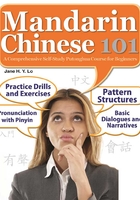
Lesson Six
Nǐ Jiā Yǒu Jǐ ge Rén?
Dialogue I


Read the following passage and say whether each of the statements is true or false.
Mǎlì jiā yǒu wŭ ge rén, tā bàba, tā māma, yī ge gēge, yī ge dìdi hé tā. Tā méi yǒu jiějie, yě méiyǒu mèimei. Tā bàba shì dàifu, tā māma shì lǎoshī. Tā dìdi shì zhōngxuésheng. Tā gēge zài Xiānggǎng zuò shēngyi. Yīnwéi Mǎlì de fùmŭ hé dìdi dōu zài Měiguó, tā hěn xiǎng tāmen, suǒyǐ Mǎlì chángcháng gěi tāmen fā diànyóu, yǒushíhou yě gěi tāmen dǎ diànhuà.

Notes
1 “gè” is a measure word, which is used between numbers and nouns to indicate the count of the nouns. In Chinese we have a lot of measure words. Different nouns usually require different measure words. “gè” is the most common one. For details,please read the grammar section for this lesson.
2 “zài’ in this dialogue can be used as a verb. The meaning is “to be in or to be at”. For example, Tāmen dōu zài Měiguó (They are both in America.) or Wǒ gēge xiànzài zài Xiǎnggǎng. ( Now my brother is in Hong Kong.)”.
3 “zài” is also used as a preposition, together with its object makes a place adverbial adjunct, which is often placed before the verb. For example, Wǒ zài dàxué xué Pŭtōnghuà. (I study Mandarin at university.)
4 “gěi” here is also used as a preposition, together with its object makes an adverbial adjunct to express the receiver of the action expressed by the verb that follows. For example: Wǒ chángcháng gěi tāmen fā diànyóu. (I often send them emails.)
Vocabulary
